Key to Female Bumble Bees of Oklahoma
Bumble Bee Importance
Bumble bees (Bombus spp.) belong to the family Apidae, and are generalist pollinators that provide vital pollination services for horticultural and agronomical productions as well as wild flowering plants. Bumble bees use a unique form of pollination called 'buzz pollination' in which they grasp flowers while moving their wings at a high rate. This buzz pollination behavior helps release pollen from plants that have evolved to require it. Female bumble bees will collect loose pollen from their bodies to pack into the pollen basket (corbicula). one on each back leg, to back to the nest. Bumble bees provide critical ecological service in the form of pollination worldwide.
Identification
All insects have three body regions (head, thorax and abdomen), two pairs of wings and six legs. Use color patterns across head, thorax and abdomen to identify bumble bees. Male and female bumble bees differ in their color patterns. Male bumble bees can be distinguished from females by the absence of a corbicula, having longer abdomens and inability to sting. Male bumble bees are not included in the key due to color variance and infrequent encountering. In addition, another large and regularly encountered bee that resembles a bumble bee, is a carpenter bee (Xylocopa spp.). Carpenter bees are included in the key because they are common in Oklahoma.
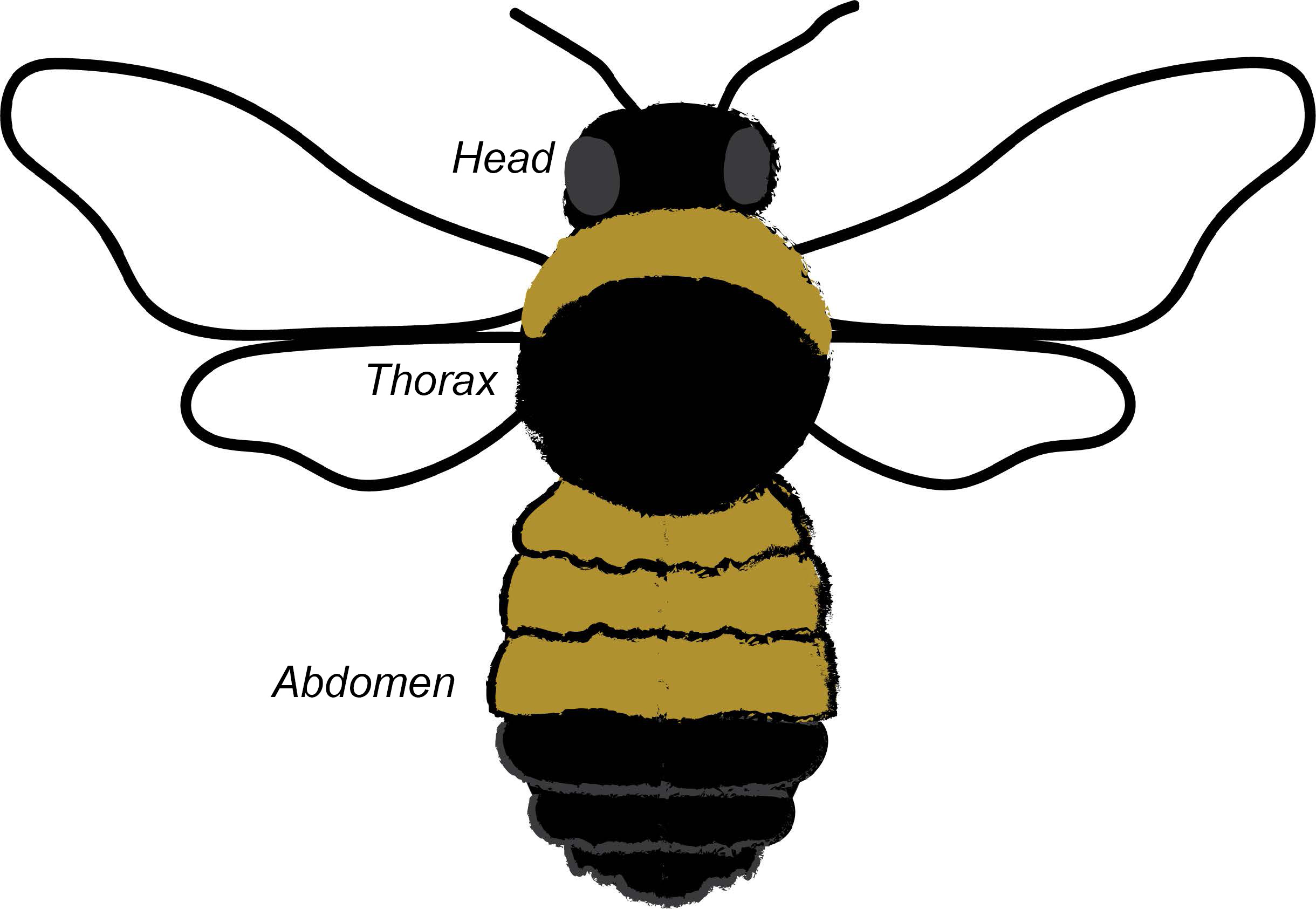
Bumble Bee Decline
Bumble bees are one of many species experiencing population declines in recent decades. Urbanization, habitat fragmentation, pesticide exposure and habitat loss contribute to bumble bee declines.
How to help bumble bees
- Reduce or eliminate the use of pesticides.
- Plant native wildflowers to provide food for native bees.
- Plant a mix of annual and perennial plants as well as plants that bloom at different times to increase availability of food.
- Reduce mowing to prevent disturbance of nests.
- Do not pick up leaves in fall. Leave them for shelter.
Have a bumble bee photo?
Researchers can use your photos to help understand the ranges, abundances and declines of bumble bee species. Upload photos to:
Recommended websites
References
Holm, H. (2017). Bees: An Identification and Native Plant Foraging Guide. Pollination Press.
Williams, P., Thorp, R., Richardson, L., & Colla, S. (2014). Bumble Bees of North America: An Identification Guide. Princeton University Press.
Wilson, J.S., & Carril, O.M. (2016). The Bees in Your Backyard: A Guide to North America's Bees. Princeton University Press.
The Xerces Society, & Spivak, M. (2011). Attracting Native Pollinators: The Xerces Society Guide, Protecting North America's Bees and Butterflies. Storey Publishing.
Key to Female Bumble Bees of Oklahoma
All bee illustrations by Emily Geest
Directions: Have your bee (or a photo) present for observation. Start at question 1 and answer the question by choosing one of the letters and proceed with directions until you reach a species.
Question 1: Is the abdomen shiny and hairless?
- 1a. Yes, abdomen shiny and hairless..................................Carpenter bee (Figure 1)
- 1b. No, abdomen fuzzy with hairs..................................Go to Question 2
Questions 2: Which pattern best matches the thorax? (Figure A)
- 2a. The thorax is solid yellow..................................Morrison's bumble bee (Figure 2)
- 2b. The thorax has a yellow collar..................................Go to Question 3
- 2c. The thorax has a black band..................................Go to Question 4
- 2d. The thorax has a center black spot..................................Go to Question 5
Question 3: Is the first abdominal segment yellow? (Figure B)
- 3a. Yes, the first abdominal segment is yellow..................................American bumble bee (Figure 3)
- 3b. No, the first abdominal segment is black..................................Black-and-gold bumble bee (Figure 4)
Question 4: Is the thorax colored white around the black band? (Figure C)
- 4a. Yes, the thorax is colored white around the black band..................................White-shouldered bumble bee (Figure 5)
- 4b. No, the thorax is colored yellow around the black band..................................Go to Question 6
Question 5: Is the entire abdomen black? (Figure D)
- 5a. Yes, the entire abdomen is black..................................Variable cuckoo bumble bee (Figure 7)
- 5b. No, the abdomen has some yellow..................................Go to Question 7
Question 6: Is the first abdominal segment black? (Figure E)
- 6a. Yes, the first abdominal segment is black..................................Indiscriminate cuckoo bumble bee (Figure 7)
- 6b. No, the first abdominal segment is yellow..................................Southern plans bumble bee (Figure 8)
Question 7: Is the second abdominal segment brown? (Figure F)
- 7a. Yes, the second abdominal segment is brown..................................Brown-belted bumble bee (Figure 9)
- 7b. No, the second abdominal segment is black..................................Common eastern bumble bee (Figure 10)
- 7c. No, the second abdominal segment is yellow..................................Go to Question 8
Question 8: Is the head entirely black? (Figure G)
- 8a. Yes, the head is entirely black..................................Two-spotted bumble bee (Figure 11)
- 8b. No, the head has some yellow hairs..................................Half-black bumble bee (Figure 12)
Bumble bee does not match the patterns listed? You most likely have a male bumble bee which has more variable color patterns. The list of suggested resources can help identify the bee further.
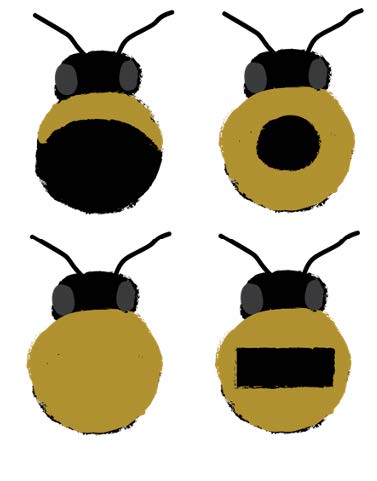
Figure A.

Figure B.

Figure C.
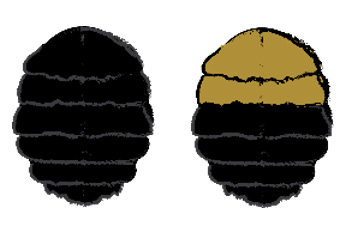
Figure D.
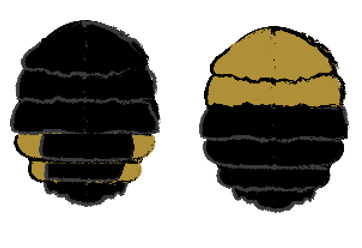
Figure E.

Figure F.
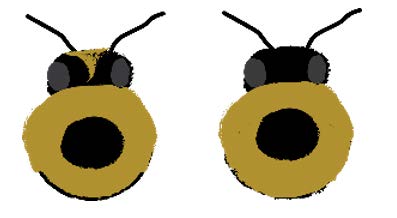
Figure G.
Note: You can make this key an all-weather field guide by placing page 2 and 3 back to back and laminating it.

